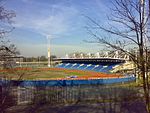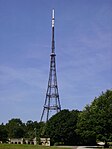Crystal Palace railway station

Crystal Palace railway station is a Network Rail and London Overground station in the London Borough of Bromley in south London. It is located in the Anerley area between the town centres of Crystal Palace and Penge, 8 miles 56 chains (14.0 km) from London Victoria. It is one of two stations built to serve the site of the 1851 exhibition building, the Crystal Palace, when it was moved from Hyde Park to Sydenham Hill after 1851. The station was opened on 10 June 1854 by the West End of London and Crystal Palace Railway (WEL&CPR) to take the crowds to the relocated Palace. It was formerly known as Crystal Palace (Low Level) to differentiate it from the nearby and now largely demolished Crystal Palace (High Level) railway station. The station serves trains running between London Bridge and London Victoria in addition to services terminating at Beckenham Junction and Sutton. Since 23 May 2010, the station has also been a terminus of the East London Line of the London Overground. This has been the catalyst for plans for a substantial redevelopment of the station.
Excerpt from the Wikipedia article Crystal Palace railway station (License: CC BY-SA 3.0, Authors, Images).Crystal Palace railway station
Crystal Palace Station Road, London Crystal Palace (London Borough of Bromley)
Geographical coordinates (GPS) Address Nearby Places Show on map
Geographical coordinates (GPS)
| Latitude | Longitude |
|---|---|
| N 51.4182 ° | E -0.0726 ° |
Address
Crystal Palace
Crystal Palace Station Road
SE19 2BF London, Crystal Palace (London Borough of Bromley)
England, United Kingdom
Open on Google Maps











